March 21, 2016
Malaika’s Costume and Maya
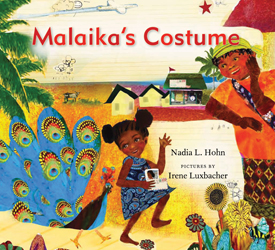 I recently had the pleasure of reviewing two absolutely beautiful picture books for Quill and Quire. Malaika’s Costume, by Nadia L. Holm and Irene Luxbacher, and Maya, by Mahakj Jain and Elly MacKay, are each exceptional books in their own right in terms of story and artwork, but when viewed together, all kinds of amazing connections occur, deepening the texture of both of them.
I recently had the pleasure of reviewing two absolutely beautiful picture books for Quill and Quire. Malaika’s Costume, by Nadia L. Holm and Irene Luxbacher, and Maya, by Mahakj Jain and Elly MacKay, are each exceptional books in their own right in terms of story and artwork, but when viewed together, all kinds of amazing connections occur, deepening the texture of both of them.
*****
From my review:
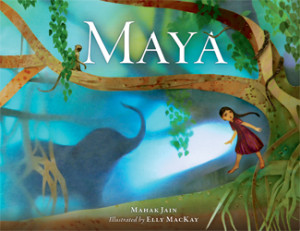 “It takes considerable talent for an illustrator to do justice to the peacock, to come even close to matching nature in rendering its most exquisite bird. With their textured and evocative illustrations in Malaika’s Costume and Maya, Irene Luxbacher and Elly MacKay, respectively, give nature a run for its money. Their images are the perfect backdrop for these deep and engaging stories about characters grappling with a parent’s absence…”
“It takes considerable talent for an illustrator to do justice to the peacock, to come even close to matching nature in rendering its most exquisite bird. With their textured and evocative illustrations in Malaika’s Costume and Maya, Irene Luxbacher and Elly MacKay, respectively, give nature a run for its money. Their images are the perfect backdrop for these deep and engaging stories about characters grappling with a parent’s absence…”
I hope you’ll read the whole thing here. This piece was such a joy to write.
March 15, 2016
If you wanna be my lover, you gotta get with my friends
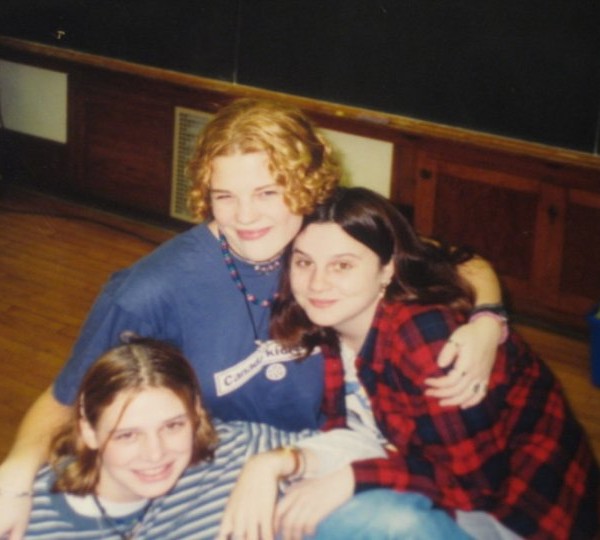
My friends at Plenty are talking about friendship throughout March, and I was pleased to contribute an essay I wrote about my nearly 25-year-old relationship with my best friends, Britt and Jennie (pictured above in Grade 10 French class, I think). I wrote about how with friendships that old, you eventually have a million things to apologize for, and also about how the Spice Girls taught us how a person should be, how our boyfriends were quite disposable, and how (in a numerical feat as remarkable as “2 Become 1”) 3 becomes 12.
December 11, 2015
The Places I’ve Been
 The best news is that I’m finally getting better, and I’ve even been to a place lately that isn’t my bed—last night I ventured out to Harriet’s holiday concert to hear her sing in the Primary Choir. This weekend, we’re planning to hang up the Christmas bunting, and the plan is that by mid-next week, I might be up and about in the world again. But until then, and even after, we’ll be taking it slow. The nice thing about the Christmas holiday is that it’s a perfect time to have that happen.
The best news is that I’m finally getting better, and I’ve even been to a place lately that isn’t my bed—last night I ventured out to Harriet’s holiday concert to hear her sing in the Primary Choir. This weekend, we’re planning to hang up the Christmas bunting, and the plan is that by mid-next week, I might be up and about in the world again. But until then, and even after, we’ll be taking it slow. The nice thing about the Christmas holiday is that it’s a perfect time to have that happen.
But other things have been happening as well, perhaps sustaining the illusion that I’ve been more active lately than I actually have been. First, the Winter 2016 issue of U of T Magazine is being mailed out soon, and it includes a short piece I wrote about the curious trajectory of my life in blogging. I wrote about how I started blogging at a point when blogs were poised to take over the world, which never quite happened, but for me (and for many others) blogging has played an enormous role in my career and evolution as a writer and a person, even. Blogging has sustained me during periods of high and lows, and through the throes of literary disappointment, and it’s now integral to my process—so much so that my forthcoming novel is about the secret life of a blogger. I was really grateful for the opportunity to write this article, and you can read it online here.
For Understorey Magazine, I got to be part of a conversation with Ali Bryan, Alice Burdick, Lorri Neilsen Glenn, Natalie Corbett Sampson, Natalie Meisner, Shalan Joudry, and Sylvia D. Hamilton about whether it’s possible to be both a mother and a writer at once. (Spoiler: I say YES). There’s lots of great advice, stories and wisdom from women who’ve been there, and I love the effect of so many voices together. I love this line from Sampson: “Shutting the world and your experience out in a ‘no diversion’ and ‘no intrusion’ approach leaves you open to missing things that can be shaped into stories. ” Naturally, I encourage women to let their children watch Annie all summer long in order to get that novel written, which worked for me. Read the whole thing here.
And finally, I took part in a very fun conversation with Corey Redekop about what happens when a wonderful writer turns out to be a terrible human being. Examining my own bookshelves, I really couldn’t find a single horrible human being among them. My authors are mainly crotchety old women, which many people construe with horrible human beinghood, but crotchetiness is these writers’ entitlement, I think. I love them better for it. Anyway, we talked about whether being an asshole was a male writer thing, I refer to Barbara Pym’s Nazi sympathies, we discuss what red lines are for us as readers (not Nazi sympathies, apparently…) and what if Rush Limbaugh was authoring the next The Phantom Tollbooth. You can read it all here.
See? I have been busy.
November 19, 2015
My review of Split, by Libby Crewman
 My first professional book review was of Libby Crewman’s The Darren Effect in Canadian Notes & Queries in 2008. It was a good book, but a messy one, and I suspect my review probably achieved a similar effect, which sadly was not an aesthetic statement, but was just me figuring out my way. But it also meant that I was looking forward to Crewman’s follow-up, Split, which was published by Goose Lane Editions in September. I read the novel twice as summer turned into fall, and it’s a story that has stayed with me since, in its oddness and perplexities, its curious sideways appeal, but also in the vivid moments that Creelman so stunningly evokes.
My first professional book review was of Libby Crewman’s The Darren Effect in Canadian Notes & Queries in 2008. It was a good book, but a messy one, and I suspect my review probably achieved a similar effect, which sadly was not an aesthetic statement, but was just me figuring out my way. But it also meant that I was looking forward to Crewman’s follow-up, Split, which was published by Goose Lane Editions in September. I read the novel twice as summer turned into fall, and it’s a story that has stayed with me since, in its oddness and perplexities, its curious sideways appeal, but also in the vivid moments that Creelman so stunningly evokes.
A remarkable feature of Split, Libby Creelman’s second novel (after 2008’s The Darren Effect; she is also author of the acclaimed 2000 story collection, Walking in Paradise) is that it isn’t split. Whereas Creelman’s previous book was an impressive tangle of multiple storylines suggesting this short story writer was still finding her way into a different literary milieu, Split—for the most part taut, controlled and smartly plotted—signals Creelman’s arrival proper as a novelist. This new book is an ambitious, assured and most accomplished whole.
This wholeness is doubly (ha!) impressive considering the novel’s movement between two moments in time—2008 on the eve of both Barack Obama’s first election victory and widespread economic meltdown, and during the hot summer of 1975, the year after Nixon’s resignation and just months after the last American troops were removed from Vietnam. The former is the novel’s present day, during which Pilgrim Wheeler returns to her hometown in rural Massachusetts to find her childhood world drastically changed, and must finally reconcile with a tragedy that had wrenched her family apart decades before.
October 17, 2015
Happy Birthday, Lillian H. Smith, and The Story Project
 Today was the Lillian H. Smith Library’s 20th birthday party, and we rushed down to College Street after Iris’s nap to catch the end of it. The library has been a special part of our family for the last five years—I wrote about it first in 2011 as part of my “Wild Libraries I Have Known” series, and it also came up in my post about Joan Bodger and Mad Men. It’s truly an extraordinary place—we were there for the Crayon Creators event just a few weeks ago, and last summer completely by mistake we stumbled upon an amazing African drumming workshop because that’s the kind of thing that just happens at the Lillian H. Smith Library.
Today was the Lillian H. Smith Library’s 20th birthday party, and we rushed down to College Street after Iris’s nap to catch the end of it. The library has been a special part of our family for the last five years—I wrote about it first in 2011 as part of my “Wild Libraries I Have Known” series, and it also came up in my post about Joan Bodger and Mad Men. It’s truly an extraordinary place—we were there for the Crayon Creators event just a few weeks ago, and last summer completely by mistake we stumbled upon an amazing African drumming workshop because that’s the kind of thing that just happens at the Lillian H. Smith Library.
So we wanted to share in the celebration, and yes, we were told there would be cake. And there was! Plus spring rolls and cups of tea (ala Alice!—“Illustrating Alice” is the exhibit currently on at the Osborne Collection of Early Children’s Books). We were glad to see our beloved Joanne, children’s librarian extraordinaire. There were crafts and face-painting. And the gorgeous bookish birthday table…
Even better? Today was also the launch of the Lillian H. Smith Library Story Project, imagined and brought to reality by the amazing Christina Wong, a library page. Over the summer she collected stories from people with connections to the library, and put them all together on the site. I was happy to share stories about how the library has been so important to my experiences as a mother and our family life in the city: you can listen to it here. (Interestingly, it’s the first time that listening to my voice has not made me want to die… I’m really pleased with how our interview turned out.)
So far I’ve also listened to Andrew Larsen on the role the library has played in his development as a children’s author, and Ken Setterington on the story of Joan Bodger and her husband’s ashes. Looking forward to listening to the rest.
And I’m so happy to have been a part of this project, which celebrates one of my favourite places in the world.
October 6, 2015
Canadian books for high school readers
This summer, I got one of the coolest gigs I’ve ever had, the opportunity to write a list of suggested Canadian fiction titles with which high school English teachers can freshen up their syllabus. As I write in the piece, I was inspired by Natalee Caple’s “Why I Teach Brand New CanLit,” which was about university classes, but her points were just as relevant for high school teachers as well. And it was no challenge to come up with the 25 titles I ultimately included in the list—I do suspect that teachers are actually spoiled for choice in this context, should they choose to be.
My list appears at Education Forum, which is the magazine of the Ontario Secondary School Teacher’s Federation. You can read it here.
October 1, 2015
The Possibility of Elephants
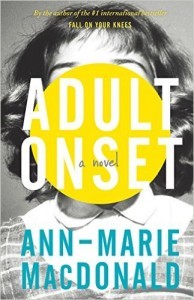 “I had a job at Pizza Hut in the last years of the old century, the location on Toronto’s Bloor Street just west of Avenue Road. I worked the take-out counter, serving ancient slices that were sweating under the heat-lamps, and one day I looked up from the till to see an elephant lumbering by, a bright emerald ribbon secured to its tail…”
“I had a job at Pizza Hut in the last years of the old century, the location on Toronto’s Bloor Street just west of Avenue Road. I worked the take-out counter, serving ancient slices that were sweating under the heat-lamps, and one day I looked up from the till to see an elephant lumbering by, a bright emerald ribbon secured to its tail…”
And so begins my essay on rereading Ann-Marie MacDonald’s Adult Onset, which is also about the mutability of memory, of literature, and of streetscapes, Bloor Street’s in particular. It’s about Balloon King, Starbucks, mistakes in fiction, parallel universes, and the Shafia family murders. It’s about Honest Eds and trauma, Daniel Libeskind’s “Crystal” and Jian Ghomeshi’s creepy voice. Plus, about having a two year old.
Anyway, I am really proud of it. As many of you already know, the word “essay” comes from the French verb “to try” and for me this piece was certainly an experiment. But I am very pleased with how it turned out, and grateful for Rohan Maitzen and her colleagues at Open Letters Monthly for their work on the piece, and for giving it such a wonderful home.
September 24, 2015
Solid Gold
This week for Picture Book Friday, I bring you the October issue of Quill and Quire, which is on newsstands now. As part of their special Kidlit Spotlight, I took part in a panel discussion focussed around the question, “Are we living in a golden age of Canadian picture books?” It was a very neat, informative and wide-ranging discussion with a bunch of kidlit experts (of which I am now—it’s official). As someone with strong opinions about most books I read, good and bad, it was interesting to hear from others with different points of view. (This is the reason I’m never going to start the blog I was born to write, called “Picture Books I Really Hate”, because these things are so subjective.) It was also really interesting to learn from people whose roots in Canadian children’s books go back to the 1970s (which is basically when Canadian children’s literature began) and find out what is different and what has stayed the same. And is this a golden age? I really do think so. I was pleased that my quotation from Ursula Nordstrom closed our discussion, about books that are written from the outside in, versus books written from the inside out (i.e. the best kind). And there is such a greater level of sophistication in Canadian books at the moment, even by the same writers who were working 30 years ago. Kathy Stinson’s Red is Best is a classic, timeless and fantastic children’s book, but her recent award-winning The Man With the Violin is on a whole other level, which is where so many picture books are appearing these days. It’s a real pleasure to be a part of this literary moment.
Also in the issue are great children’s book reviews, and plenty of other good stuff. Make sure you pick up a copy!
August 20, 2015
Preventative: The Litter I See Project
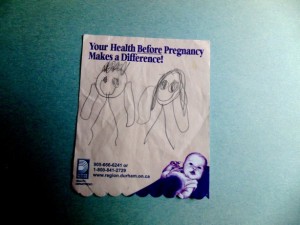 Today my short short story, “Preventative”, is up at the fantastic The Litter I See Project, a brainchild of the excellent Carin Makuz. She has enlisted a slate of Canadian writers to create a piece inspired by a piece of litter (“the litter I see”) in order to support literacy. Readers who enjoy these pieces are encouraged to make a donation to Frontier College. Find out more about the project here.
Today my short short story, “Preventative”, is up at the fantastic The Litter I See Project, a brainchild of the excellent Carin Makuz. She has enlisted a slate of Canadian writers to create a piece inspired by a piece of litter (“the litter I see”) in order to support literacy. Readers who enjoy these pieces are encouraged to make a donation to Frontier College. Find out more about the project here.
My story:
“She’s all arms and legs, that girl,” was what everybody kept saying to Myra when Teeny turned six and got gangly. Which irritated Teeny, who was not only pedantic but also sensitive to remarks about her appearance, and so she’d glare at whoever was speaking and she’d say, “That’s not even true. I have a body.” Slapping her bum to make the point, storming away, a tornado of limbs. Eventually Myra’s sister felt she had to have a word.
“That girl needs to learn to watch her tone.”
May 31, 2015
Close to Hugh in Globe Books
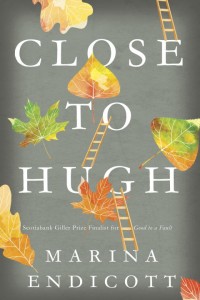 My review of Marina Endicott’s new novel, Close to Hugh, appeared in the Globe and Mail this weekend. It’s a book so very much about its own style, its words as materials, and I found myself wanting to respond in a way that honoured that. I’m so pleased with what I came up with, which was a pleasure to write, because there is so much remarkable and interesting about Endicott’s huge and sprawling novel. It’s not perfect, but it’s never boring, and it’s so original and ambitious. I read it twice in April, book-ends to our England trip, and now I’ve got nostalgia now for its pages and how they remind me of suitcases and waiting for our taxi to come.
My review of Marina Endicott’s new novel, Close to Hugh, appeared in the Globe and Mail this weekend. It’s a book so very much about its own style, its words as materials, and I found myself wanting to respond in a way that honoured that. I’m so pleased with what I came up with, which was a pleasure to write, because there is so much remarkable and interesting about Endicott’s huge and sprawling novel. It’s not perfect, but it’s never boring, and it’s so original and ambitious. I read it twice in April, book-ends to our England trip, and now I’ve got nostalgia now for its pages and how they remind me of suitcases and waiting for our taxi to come.
From my review: “Rich with adjectives, the novel addresses huge and general questions about the meaning of life and the universe with remarkable specificity. ‘We are tiny, unknowable, unimaginably unimportant, far from everything, only close to each other,’ one character observes, which on a macro level is the point of Close to Hugh but, as the novel demonstrates, is also totally wrong. Because of how art itself brings the world into startling, vivid focus, and suddenly every little thing has meaning after all.”









